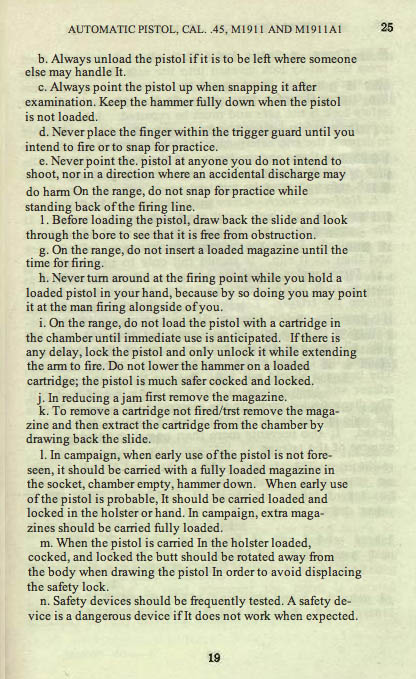b. Always unload the pistol if it is to be left where someone else may handle It. c. Always point the pistol up when snapping it after examination. Keep the hammer fully down when the pistol is not loaded. d. Never place the finger within the trigger guard until you intend to fire or to snap for practice. e. Never point the. pistol at anyone you do not intend to shoot, nor in a direction where an accidental discharge may do harm On the range, do not snap for practice while standing back of the firing line. 1. Before loading the pistol, draw back the slide and look through the bore to see that it is free from obstruction. g. On the range, do not insert a loaded magazine until the time for firing. h. Never turn around at the firing point while you hold a loaded pistol in your hand, because by so doing you may point it at the man firing alongside of you. i. On the range, do not load the pistol with a cartridge in the chamber until immediate use is anticipated. If there is any delay, lock the pistol and only unlock it while extending the arm to fire. Do not lower the hammer on a loaded cartridge; the pistol is much safer cocked and locked. j. In reducing a jam first remove the magazine. k. To remove a cartridge not fired/trst remove the maga- zine and then extract the cartridge from the chamber by drawing back the slide. l. In campaign, when early use of the pistol is not fore- seen, it should be carried with a fully loaded magazine in the socket, chamber empty, hammer down. When early use of the pistol is probable, It should be carried loaded and locked in the holster or hand. In campaign, extra maga- zines should be carried fully loaded. m. When the pistol is carried In the holster loaded, cocked, and locked the butt should be rotated away from the body when drawing the pistol In order to avoid displacing the safety lock. n. Safety devices should be frequently tested. A safety de- vice is a dangerous device if It does not work when expected.


Comments, suggestions, contributions? Let me know